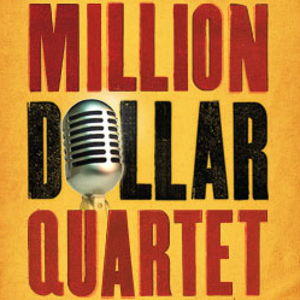
Overview
Synopsis
On December 4, 1956, Johnny Cash, Jerry Lee Lewis, Carl Perkins, and Elvis Presley all found themselves at Sun Records in Memphis, Tennessee, and proceeded to record a legendary jam album. A Tony® Award Winning musical, Million Dollar Quartet recounts that single night with the meaningful and humorous story of five men’s journeys through the music business. A venerable rock concert where audiences relive the glory days of early rock and roll, the score features major hits performed live onstage by legendary characters.
Show Information
Context
As the jukebox musical was revived in the early 2000’s, Million Dollar Quartet found success among audiences and music fans across the United States, Canada, and London. After premiere productions in Florida and Washington, the show enjoyed a wildly successful run in Chicago, and became the city’s third-longest running show, running 2008-2016. When it went to Broadway in 2010, the show garnered three Tony nominations, including one win (a Best Featured Actor in a Musical award for Levi
to read the context for Million Dollar Quartet and to unlock other amazing theatre resources!Plot
Sam Philips introduces the audience to his blossoming recording business, Sun Records, in Memphis Tennessee. He recounts the very special night that made rock and roll history.
Sam is hosting a recording session for Carl Perkins, original recording star of “Blue Suede Shoes.” Sam is pairing him with an upstart and unknown pianist, Jerry Lee Lewis, in an attempt to revitalize his career. Carl has brought with him his brother, a bassist, and a drummer. Sam tells the story of how he originally
to read the plot for Million Dollar Quartet and to unlock other amazing theatre resources!Characters
| Name | Part Size | Gender | Vocal Part |
|---|---|---|---|
|
Lead |
Male |
Tenor |
|
|
Lead |
Male |
Tenor, Baritone |
|
|
Lead |
Male |
Baritone, Bass |
|
|
Lead |
Male |
Tenor |
|
|
Supporting |
Male |
Spoken |
|
|
Featured |
Female |
Mezzo-Soprano |
|
|
Featured |
Male |
Silent |
|
|
Featured |
Male |
Silent |
Songs
Blue Suede Shoes - Company
Real Wild Child - Jerry Lee Lewis
Matchbox - Carl Perkins
Who Do You Love? - Carl Perkins
Folsom Prison Blues - Johnny Cash
Fever - Dyanne
Memories Are Made of This - Elvis Presley
That's All Right - Elvis Presley
Brown Eyed Handsome Man - Company
Down by the Riverside - Company
Sixteen Tons - Johnny Cash
My Babe - Carl Perkins
Long Tall Sally - Elvis Presley
Peace in the Valley - Company
I Walk the Line - Johnny Cash
I Hear You Knockin' - Dyanne
Party (Let’s Have A Party) – Company
Great Balls of Fire - Jerry Lee Lewis
Down by the Riverside (Reprise) - Company
Hound Dog - Elvis Presley
Riders in the Sky - Johnny Cash
See You Later, Alligator - Carl Perkins and Company
Whole Lotta Shakin' Goin' On - Jerry Lee Lewis and Company
A song with an asterisk (*) before the title indicates a dance number; a character listed in a song with an asterisk (*) by the character's name indicates that the character exclusively serves as a dancer in this song, which is sung by other characters.
Monologues
Scenes
Key Terms
Sorry! We do not currently have terms for this guide.
Videos
Quizzes
Themes, Symbols & Motifs
Sorry! We do not currently have learning modules for this guide.
Quote Analysis
Sorry! We do not currently have learning modules for this guide.
